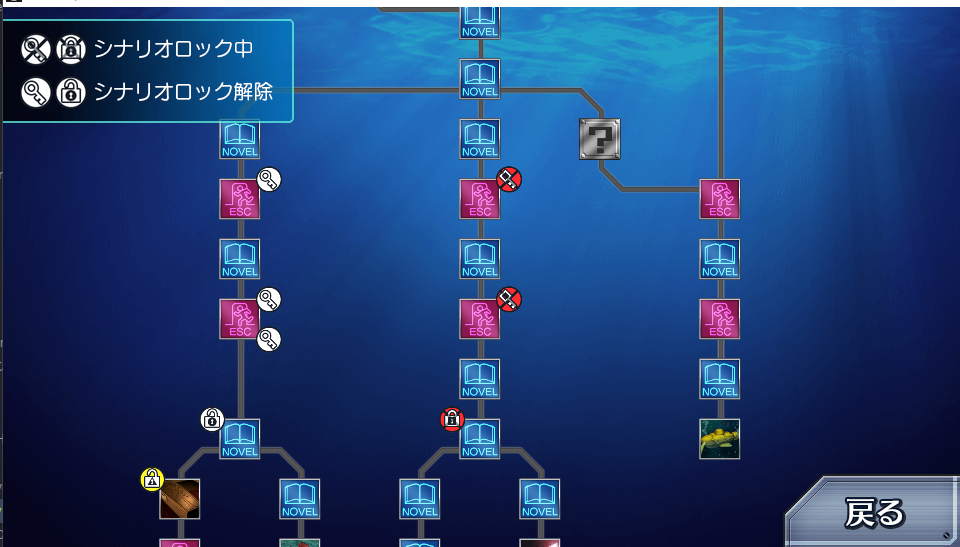For this critical play, I went back and revisited a game I cleared in February, but this time, I played from a designer’s perspective. The game is called Zero Escape: Nine Hours, Nine Persons, Nine Doors, and it was developed by Spike Chunsoft and originally published in 2009. It was first released on Nintendo DS and later ported to iOS, PC, and PS4. It is a single-player visual novel with puzzle-solving and mystery elements.
Formal Elements
Objectives and Enacting Narratives

(The image above shows a flow chart of the game. There are different routes, each leading to a different ending.)
The main objective of the game is to progress through the story and reach all the endings, in which all truths are unveiled. The game has six different endings, and the player’s choice they make in the game will affect the direction of the story. The story follows Junpei, who wakes up and realized he is trapped in a cell room on a sinking cruise. After he escapes the cell room, he rendezvouses with 8 other people, who are also trapped on this cruise. A sound from the broadcast informs these 9 people that they are participating in a death game, where they need to find their way out of this cruise in 9 hours, or the cruise will sink and all of them will die.
Both the narrative structure and the story setting make the mystery aspect of the game prominent and appealing. The narrative is mostly linear, but since there are a few routes that lead to different endings, there are different possible directions the story can go in. In each route, only limited clues are provided and some of the truth but revealed, but the additional information we obtain before reach the true ending brings more confusion most of the time. This information is usually misleading or only telling part of the truth, and it makes the story seem more mysterious. Since the player plays as Junpei, the player follows his line of thought most of the time and can get trapped in his logic and thoughts, which is also intended by the game developer, as a result of such enacting narratives.
The “death game” setting is unnerving but serves a role in keeping the player focusing on the story well, only to be overwhelmed by the plot twists, sudden reveals, and intricate background settings. Also, the setting makes it easy for the player to invest themselves in the story and characters because people tend to give more care and attention when they are in a dangerous situation.
Procedures and Embedded Narratives
(In the above scene during an escape section, all objects in the scene can be clicked to investigate.)
The game is divided into two types of sections: novel and escape. The novel section is where the story proceeds and the protagonist converse and interact with other characters. There are very few tasks the player needs to do in the novel section; they only need to focus on the story. The escape sections are inserted into the novel sections: from time to time, the player finds them in a room that they need to escape, so they need to investigate the room by clicking on different parts of the screen and find clues that hint at how to open the doors to escape.
The escape sections in this game, different from real-life escape rooms, have an overarching story behind them. Although the purpose of the escape sections is usually escaping the room, clues found in these rooms provide foreshadowing information or clues to the truth related to the story in addition to how to open the doors to escape. These small pieces we gather from every escape room bring us closer to the truth. They are perfect examples of how embedded narratives are utilized in this game.
Fun
Challenge
The puzzles in the escape sections can be hard and/or tricky. Some level of Mathematical and logical thinking skills are needed, and the puzzles can pose challenges to the players.
Narrative
The story is convoluted but very good. Both enacting and embedded narratives can get the player invested in the story and characters quite easily, and the final ending of the game is very satisfying. Both the process of looking for truth and reaching the end of the story can bring great fun to the player.
What Can Be Improved
Overall this game was very fun to play, but there are still places that can be improved. First, the style of the game sometimes shifts too quickly: 2 seconds ago everyone was having a lighthearted conversation, and now a gruesome murder scene shows up all of a sudden. I hope the game could include a little bit more buffer for this kind of shifts. Additionally, the music is kind of forgettable. I’m a person who values music a lot in story-focused games, and I think better music can improve the experience by a lot.



